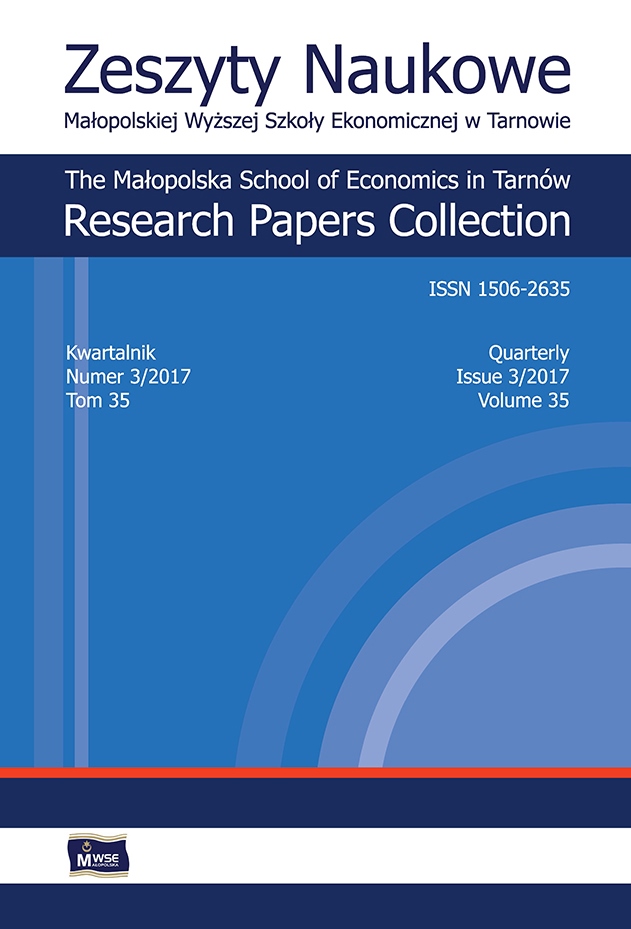Abstract
Despite being sometimes compared to neighbors and satellite offices, coworking is a brand new system of office work, falling between conventional employment and working at home. In this system, individual entrepreneurs—freelancers—work at their own businesses, sharing office space at the same time. Its history is relatively short, just slightly over 10 years. However, since the first coworking office was founded in 2006, the movement has become largely popular; moreover, it is forecast that there should be at least 1.2 million active users of coworking spaces by the end of 2017. The purpose of the article is to describe Polish coworking spaces with a particular emphasis on Cracow being the second largest city in Poland and the biggest regional office work markets in the country. In order to present coworking phenomenon properly, still unfamiliar to a broad group of consumers, the analysis of the Cracow market has been preceded by a comprehensive introduction devoted to the discussion of the global tendencies, principles of offices organization including their types and history of origin supported with examples of interesting centres in Western Europe and the United States. Against this background, the results of coworking spaces in Cracow research are presented, together with examples, conducted during the period from January to March 2017. The statistical data concerning Cracow shared work spaces are confronted with the values characteristic for the Warsaw market being indisputably the largest and the most dynamic centre in the country, which is aimed at determination of the overall situation of coworking in Poland and provides the basis for determination of development tendencies of this form of work organization.
References
Aouf, R.S. (2016a). Antwerp co-working space by Going East encourages occupants to explore its diverse spaces [online, dostęp: 2017-02-16]. Dezeen Website. Dostępny w Internecie: https://www.dezeen.com/2016/12/21/antwerp-co-working-space-fosbury-sons-office-interior-design-going-east/.
View in Google Scholar
Aouf, R.S. (2016b). Tom Dixon’s Atrium co-working space opens in London [online, dostęp: 2017-03-16]. Dezeen Website. Dostępny w Internecie: https://www.dezeen.com/2016/05/19/tom-dixon-research-design-studio-atrium-co-working-space-interior-camden-london-uk/.
View in Google Scholar
Clark, J. (2007). Coworkers of the world unite [online, dostęp: 2017-02-04]. The American Prospect, October 1. Dostępny w Internecie: http://prospect.org/article/coworkers-world-unite.
View in Google Scholar
Coworking. (2017). W: Oxford Dictionaries [online, dostęp: 2017-01-21]. Dostępny w Internecie: https://en.oxforddictionaries.com.
View in Google Scholar
Deskmag. (2016) Coworking in the U.S. 2016. Results of the global coworking survey [online, dostęp: 2017--03-24]. Deskmag’s presentation of the US results on coworking 2016 at GCUC, Los Angeles, May 5, 2016. Dostępny w Internecie: https://www.slideshare.net/carstenfoertsch/coworking-in-the-usa-2016.
View in Google Scholar
Deskmag. (2017). Witryna internetowa [dostęp: 2017-01-21]. Dostępny w Internecie: deskmag.com.
View in Google Scholar
Florida, R. (2012). The Rise of Creative Class. New York: Basic Books. ISBN 9780465029938.
View in Google Scholar
Forlano, L. (2009). Work and the open source city [online, dostęp: 2017-03-15]. Urban Omnibus. Dostępny w Internecie: http://urbanomnibus.net/2009/06/work-and-the-open-source-city.
View in Google Scholar
Fosbury & Sons Co-Work / Going East. (2015). ArchDaily [online, dostęp: 2017-03-18]. Dostępny w Internecie: http://www.archdaily.com/802824/fosbury-and-sons-co-work-going-east.
View in Google Scholar
Fost, D. (2008). They’re working on their own, just side by side. New York Times, February 20.
View in Google Scholar
Gandini, A. (2015). The rise of coworking spaces: A literature review. Ephemera. Theory & Politics in Organization, 1, 193–205.
View in Google Scholar
JLL. (2016). The new era of coworking [online, dostęp: 2017-03-24]. Dostępny w Internecie: http://www.jll.eu/emea/en-gb/Documents/co-working/doc/JLL_Coworking-Trends-Report.pdf.
View in Google Scholar
Lange, B. (2011). Re-scaling governance in Berlin’s creative economy. Culture Unbound, 3, 187–208.
View in Google Scholar
Mairs, J. (2015). Pop-up office created around a tree trunk in London’s Hoxton Square [online, dostęp: 2017-03-16]. Dezeen Website. Dostępny w Internecie: https://www.dezeen.com/2015/06/11/pop-up-temporary-office-pilot-hoxton-square-shoreditch-hackney-parks-east-london-rooted-to-tree-trunk-translucentpod/.
View in Google Scholar
Mairs, J. (2017). SelgasCano completes plant-filled co-working space inside Lisbon market hall for Second Home [online, dostęp: 2017-03-15]. Dezeen Website. Dostępny w Internecie: https://www.dezeen.com/2017/02/14/second-home-lisboa-market-hall-co-working-plants-office-selgascano-portugal/.
View in Google Scholar
McKnight, J. (2016). Lesser Architecture transforms Brooklyn factory into colorful co-working space [online, dostęp: 2017-03-16]. Dezeen Website. Dostępny w Internecie: https://www.dezeen.com/2016/03/08/coworking-space-office-interior-leeser-architecture-coworkrs-brooklyn-new-york/.
View in Google Scholar
Merkel, J. (2015). Coworking in the city. Ephemera. Theory & Politics in Organization, 1, 121–139.
View in Google Scholar
Moriset, B. (2014). Building new places of the creative economy. The rise of coworking spaces. 2nd Geography of Innovation International Conference. Utrecht: Utrecht University.
View in Google Scholar
Reed, B. (2007). Co-working: The ultimate in teleworking flexibility [online, dostęp: 2017-02-04]. Network World. Dostępny w Internecie: http://www.networkworld.com/article/2287504/computers/co-working-the-ultimate-in-teleworking-flexibility.html.
View in Google Scholar
Spinuzzi, C. (2012). Working alone together. Coworking as emergent collaborative activity. Journal of Business and Technical Communication, 26(4), 399–441.
View in Google Scholar
Statista. (2017). Number of coworking spaces worldwide from 2005 to 2017 [online, dostęp: 2017-03-15]. Statista: The Statistical Portal. New York: Statista Inc. Dostępny w Internecie: http://www.statista.com/statistics/554273/number-of-coworking-spaces-worldwide/.
View in Google Scholar
Sturges, S. (2016). Interchange: Barr Gazetas and Tom Dixon create Camden co-working space [online, dostęp: 2017-03-18]. Wallpaper, May 23. Dostępny w Internecie: https://www.wallpaper.com/architecture/barr-gazetas-and-tom-dixon-create-camden-co-working-space-interchange.
View in Google Scholar
The Warsaw Hub. (2017). Wikipedia: wolna encyklopedia [online, dostęp: 2017-04-01]. Dostępny w Internecie:https://pl.wikipedia.org/wiki/The_Warsaw_Hub.
View in Google Scholar
US w Krakowie. (2017). M[iasto] Kraków [online, dostęp: 2017-03-24]. Kraków: Urząd Statystyczny. Dostępny w Internecie: http://krakow.stat.gov.pl/zakladka2/.
View in Google Scholar
US w Warszawie. (2017). Warszawa [online, dostęp: 2017-03-24]. Warszawa: Urząd Statystyczny. Dostępny w Internecie: https://warszawa.stat.gov.pl/warszawa/.
View in Google Scholar
Złowodzki, M. (1992). O środowisku architektonicznym pracy biurowej. Kraków: Wydawnictwo Politechniki Krakowskiej.
View in Google Scholar
© Copyright by Małopolska School of Economics in Tarnów. The articles are available under the Creative Commons Attribution NonCommercial-NoDerivatives 4.0 International License


